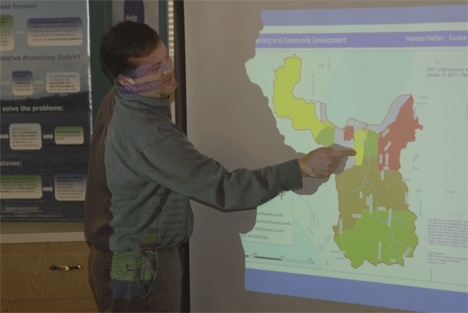FREELAND — For Island County, the tide has slowly begun to turn in Freeland’s quest to find the source of pollution that’s fouling Holmes Harbor.
High levels of the bacteria fecal coliform were discovered during routine state Department of Health surveys conducted in 2005 in the southern tip of Holmes Harbor. The following year, the county health department closed the harbor for shellfish harvesting, and the county later designated the area as a shellfish protection district.
But since then, the county has faced an uphill battle in finding the source of the pollution. A major problem was the dry spell that hampered water quality tests when monitoring began.
Chris Wilson, assistant planning director with Island County, said dry conditions persisted until the fall. With the return of consistently wet weather late last year, Wilson and other county employees have since been able to collect samples from watersheds near Holmes Harbor.
They are starting to see some initial patterns emerging, he said.
The tests shows a range of low, moderate and high contamination levels on the land around the southern end of Holmes Harbor.
Contamination is measured in colony forming units per milliliter of fresh water.
“200 CFUs is a bacteria count and it’s in the state standard,” Wilson said.
After evaluating the data, Wilson found two areas within the district that consistently had more than 200 CFUs.
One area is nearly adjacent to Nichols Brothers Boat Builders and Freeland Hall, between Woodard Avenue and Freeland Avenue bordering East Shoreview Drive.
The other area that poses high contamination risk occurs north of Main Street all the way to East Watkins Road, along South East Harbor Road
“We’ve measured more than 200 CFUs enough times that we feel pretty confident that’s a fair number. We have enough data points,” Wilson said.
But the watersheds that rim Holmes Harbor are already showing signs of drying up again, Wilson said. The short period of time for taking samples could cost him more time.
“It may take a few years. As frustrating as it is, we’ve had high hopes of being able to move up and have a more rapid response,” he said.
“The reality of it is we’re somewhat hamstrung by the flow we get in there.”
During a recent meeting with community members in Freeland, officials from the state Department of Health lauded Island County’s efforts as compared to other shellfish protection districts within Puget Sound.
“What we’re looking at doing is getting water quality improvement in the streams that flow into the headwaters of the bay,” said Lawrence Sullivan, public health advisor for the Office of Shellfish and Water Protection.
Sullivan said he liked what he has seen so far with Whidbey’s early work on its shellfish protection district in Freeland.
“You want to see people involved. You want to see groups out on the ground sampling; involved with education and outreach efforts. I am encouraged by the efforts the county has put into this,” he said.
Wilson said more may need to be done, including more frequent tests when conditions allow.
“It does provide me comfort to know at least we’re on the right track. Sampling more often than twice a month may be a tack we have to take knowing that these watersheds typically don’t flow as often as we’d like,” he said.
“We may have to recognize that we have a smaller and smaller window than we thought we would and really concentrate on sampling the waters,” Wilson said.
Wilson added that more data will help determine the source of the pollution. The county can then concentrate on an educational outreach effort to landowners of properties that are contributing to the pollution problem.
“One of our next steps is to go through and look at our landscape analysis to understand potentially what is in these areas,” he said. “If we can isolate woods from residential areas, then maybe it’s only a development problem and not a natural problem in the watershed.”
With the state Department of Health reporting clean marine waters, some community members questioned why it was necessary to maintain the shellfish protection district.
For Wilson, it is a question of potentials, not absolutes.
“This is a risk-based assessment. On any given individual day, you may be fine (to eat shellfish or swim in the harbor.) But there is elevated risk that one day it won’t be fine,” Wilson said.
“We don’t know what causes the fecal coliform contamination in the water,” he added. “It could be a horse, it could be a pig, a human or it could be a cow.”
Spencer Webster can be reached at 221-5300 or swebster@southwhidbey
record.com.



